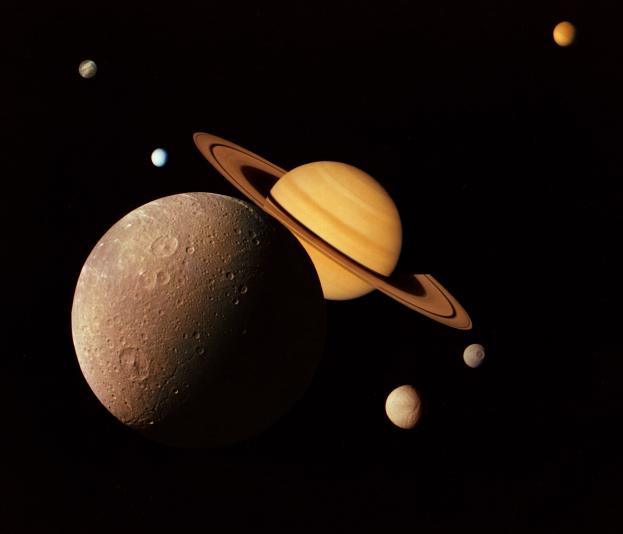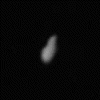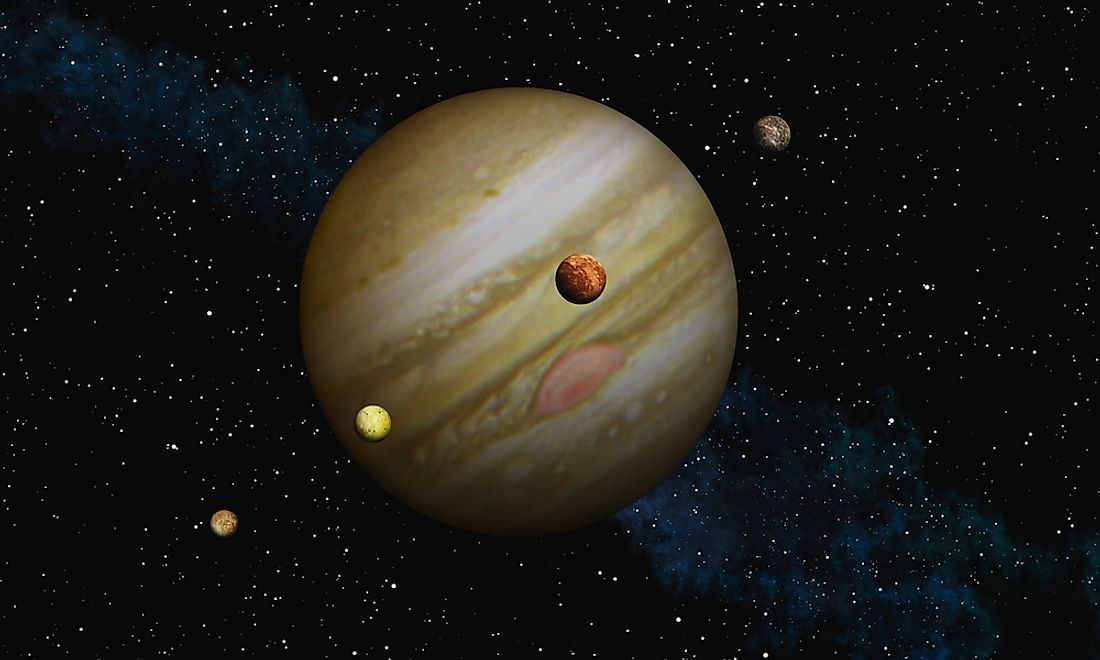The Moons of Saturn
Of all the planets, Saturn reigns supreme, well at least in the moon department. That is because Saturn has more moons than any other planet, 62 currently, and counting. Of these 62 moons, 53 are classified officially as moons, 9 are provisional (unofficial) moons. We’ll talk about a few of the moons below.
|
Although most of Saturn’s moons are small, a few such as Titan are very large. Many of Saturn’s moons orbit around the edge of the planet’s rings. They help to keep the rings in place, just as a shepherd keeps sheep in place. For this reason we call these moons Shepherd Moons. |
|
Pan Pan is the closest known moon to Saturn’s surface. It was discovered by Mark R. Showalter in 1990, by looking at pictures sent back from Voyager. Because Pan is very small and so far away, there is not much we know about it. This moon was named after the god of woods, fields and flocks, having a human body and head, and goat legs, horns and ears. |
|
Atlas Atlas is the second of Saturn’s moons. Discovered in 1980 by R. Terrile, it orbits Saturn just to the side of the A Ring. This makes Atlas a shepherd moon. Atlas was also known by the name Hercules in mythology. |
|
Prometheus Prometheus, which was discovered by S. Collins and others in 1980, is the inner shepherd satellite of Saturn’s F ring. Prometheus was named after a man who stole fire from Olympus and gave it to humankind in Greek mythology. It is the third closest moon to the surface of Saturn. |
|
Pandora The outer shepherd moon of the F Ring is named Pandora. This small moon was discovered in 1980 by S. Collins. The name Pandora comes from Greek mythology. She was the first woman sent to Earth by Jupiter as a punishment for Prometheus’ theft of fire. According to the story, Jupiter sent her to Earth with a box of all the problems and sicknesses of life. She opened the box out of curiosity, releasing all these ills on humankind. |
|
Epimetheus Epimetheus is the fifth moon from Saturn’s surface. It was discovered by Richard Walker first in 1966, and then again in 1977 by Stephen Larson and John Fountain. These three officially share the discovery. In 1966 Epimetheus was confused with Janus, another of Saturn’s moons. Epimetheus and Janus are very interesting moons. They actually trade places with each other every 4 years. In Greek mythology Epimetheus was the husband of Pandora. |
|
Janus Janus was discovered by the French astronomer Audouin Dollfus in 1966. The name Janus comes from the Greek god of gates and doors. Janus is also the root of the name January. |
|
Mimas Mimas reveals a striking resemblance to the Death Star in the popular film Star Wars. It is for that reason nick named by astronomers “The Death Star.” The large crater, which you can see, is named Herschel. It is so big compared to the size of Mimas, that whatever hit the moon probably just about tore it apart. Notice how round Mimas is. This is because it is big enough that its gravity can pull the material into a globe. Many of Saturn’s moons are too small to be pulled into a globe shape. Mimas was discovered in 1789 by William Herschel. This moon was named after one of the Titans slain by Hercules. |
|
Enceladus The eighth moon orbiting Saturn is Enceladus. In Greek mythology Enceladus was a Titan who was defeated in battle and buried under Mount Etna by Athena. Discovered in 1789 by William Herschel, Enceladus is the brightest object besides the Sun in the Solar System. Of course, on Earth we cannot see it at all without a telescope. This is because it is small and far away. The smooth surface of Enceladus tells scientists that it has recently been active. Scientists do not know for sure whether it is water, volcanic or other material that has erupted in the last 100 million years giving this moon such a smooth face. |
|
Tethys Tethys is like a giant ice cube in the sky. It is almost pure water ice. At one time long ago it was liquid. It would have been a giant ocean with no land and no seabed. Or like a giant blob of water floating in the sky. In Greek mythology Tethys was a Titaness and sea goddess who was both sister and wife of Oceanus. This moon was discovered by Cassini in 1684. |
|
Telesto The tenth world orbiting Saturn is named Telesto. Telesto was discovered in 1980 by Smith, Reitsema, Larson and Fountain. Telesto is one of the smallest moons in the Solar System. In Greek mythology Telesto was a daughter of Oceanus and Tethys. |
|
Calypso Discovered by Pascu, Seidelmann, Baum and Currie in 1980, Calypso was named for a sea nymph who delayed Odysseus on her island for seven years. Like Telesto, Calypso is one of the smallest moons in the Solar System. |
|
Dione The twelfth moon from Saturn is named Dione. This world was discovered in 1684 by Cassini. Dione is the densest, or heaviest of Saturn’s moons. Dione was the mother of Venus in Greek Mythology. |
|
Helene Helene is the thirteenth of Saturn’s moons. It was discovered by Lecacheux and Laques in 1980. Not much is known about this moon, although the Cassini Spacecraft recently flew close to Helene and took a great picture of its surface. Helene was an Amazon who fought with Achilles in Greek Mythology. |
|
Rhea Rhea is the second largest of Saturn’s Moons. In Greek Mythology Rhea was the wife of Saturn and the mother of Neptune, Jupiter and Pluto. This world was discovered in 1672 by Cassini. |
|
Titan Discovered by Huygens in 1655, Titan is the largest moon orbiting Saturn, and the second largest moon in the Solar System. It is bigger in diameter than both the planets Mercury and Pluto and also larger than Earth’s moon. It contains an atmosphere far thicker than even that of the Earth. Unfortunately scientists don’t know very much about this world because they have not yet been able to penetrate its thick clouds to photograph its surface. |
|
Hyperion Saturn’s Sixteenth moon was discovered by Bond and Lassell in 1848. Hyperion is the largest object in the Solar System that is not ball shaped. Its size and shape tells scientists that it probably used to be part of a larger rounder moon which somehow broke apart. In Greek mythology Hyperion was the son of Earth and Uranus. |
|
Iapetus Iapetus, which was discovered by Cassini in 1671, is another world made up almost entirely of water ice. Most of Saturn’s moons orbit the planet on the same plane, the plane of the planet’s equator. This ice cube does not, however, follow the same path that Saturn’s other moons follow. Instead, it orbits Saturn from top to bottom. In Greek mythology Iapetus was the son of Uranus. He was also an ancestor to the Human Race. |
|
Phoebe Phoebe is 4 times more distant from Saturn than Iapetus, its nearest neighbor. This small world was discovered by Pickering in 1898. Phoebe is much darker than most of the other moons of Saturn, and like Iapetus, it orbits Saturn nearly top to bottom instead of around its equator Both of these facts lead scientists to believe that phoebe is probably a captured asteroid or comet. In Greek mythology Phoebe is the daughter of Uranus and Earth. |
|
New Moons The following moons have only recently been discovered. There is still only very little information about these worlds: S/2007 S2, S/2007 S3, S/2009 S1, Surtur, Aegaeon, Anthe, Tarqeq, Jarnsaxa, Greip, Skoll, Loge, Kari, Hati, Hyrrokkin, Fenrir, Farbauti, Bestla, and several others. |
|
























